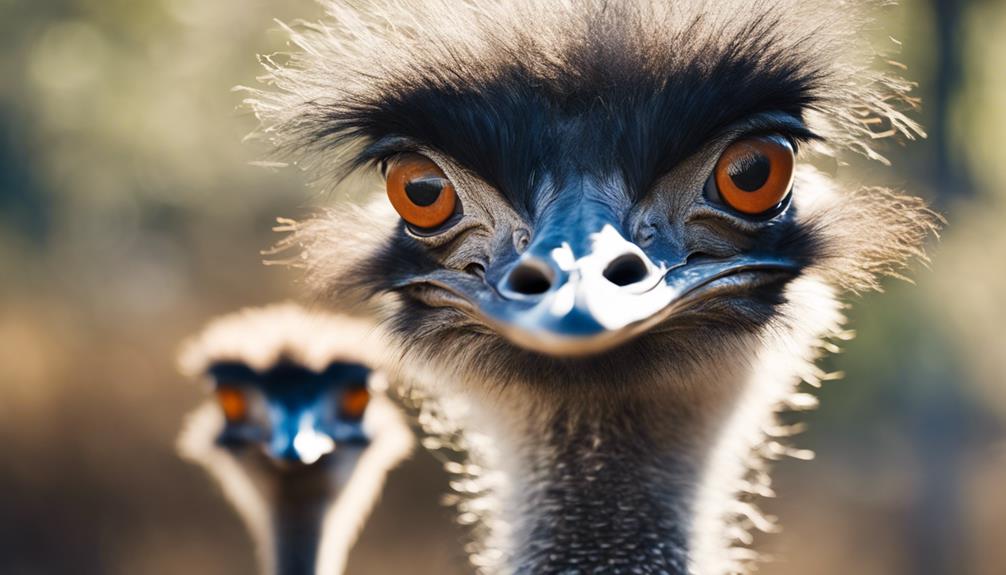
You might not be aware that Emus and ostriches, despite their similar appearance, possess distinct characteristics that set them apart in the avian world. Have you ever wondered about the intriguing differences between these two fascinating flightless birds? Let's dive into the unique features and behaviors that define the Emu versus Ostrich debate, shedding light on their contrasting traits and evolutionary adaptations.
Key Takeaways
- Emus are smaller, weighing 80-130 lbs, while ostriches are larger, weighing 220-350 lbs.
- Emus have brown mottled feathers, whereas ostriches have primarily black feathers with white plumage.
- Emus have a neck length of around 1.3-1.5 meters, while ostriches have a neck up to 9 feet long.
- Emus are adapted for Australian bushlands, while ostriches thrive in African savannas.
- Emus can run up to 30 mph, but ostriches are the fastest land birds, sprinting over 45 mph.
Physical Size
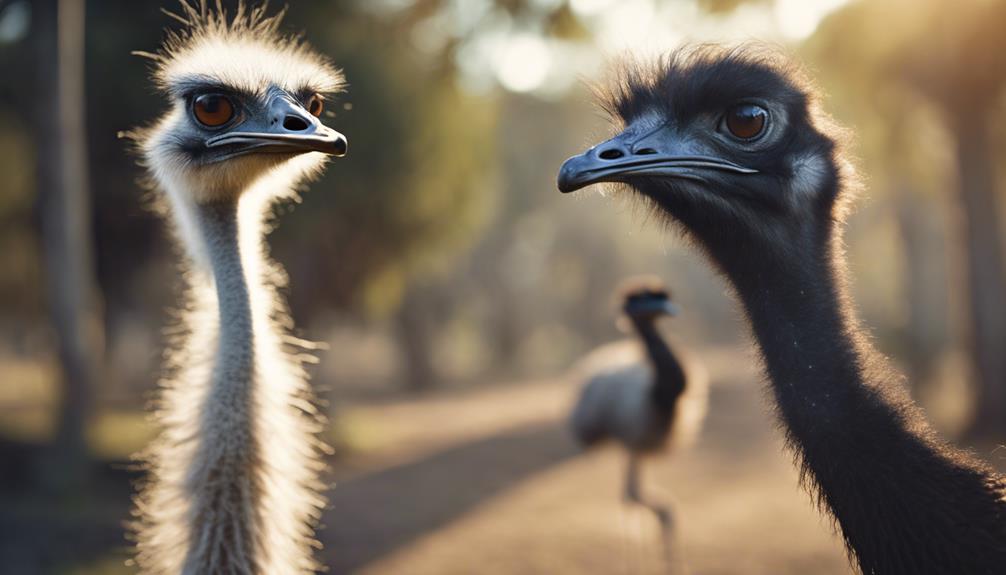
When comparing the physical sizes of emus and ostriches, one can immediately notice striking differences in height and weight. Emus generally stand around 5 to 6.5 feet tall, while ostriches tower at heights ranging from 7 to 9 feet. In terms of weight, emus weigh between 80 to 130 pounds, whereas ostriches can weigh anywhere from 220 to 350 pounds. These disparities in size aren't just superficial; they also reflect the different habitats and evolutionary paths of these magnificent birds.
The emu, with its slightly smaller stature, is adapted to thrive in a variety of habitats, from forests to open plains. Its size allows for agility and speed, making it a formidable creature in its environment. On the other hand, the ostrich's impressive height and weight are suited for the vast open spaces of the savannas and deserts it inhabits. These physical characteristics contribute to the dominance and power these birds exhibit in their respective territories.
Feather Coloration
Comparing the feather coloration of emus and ostriches reveals distinct differences in their plumage hues and patterns. Emus, known for their predominantly brown feathers, display a range of shades from dark brown to a lighter, almost grey-brown coloration. Their feathers are often mottled, providing them with effective camouflage in their natural habitats.
In contrast, ostriches showcase primarily black feathers, with some white plumage on their wings and tail. The stark contrast between the black and white feathers creates a striking appearance, especially during displays of courtship or aggression.
Additionally, emus have distinct banding patterns on their feathers, with alternating dark and light bands creating a unique visual effect. Ostriches, on the other hand, exhibit a more uniform coloration across their feathers, with minimal patterning or banding. These differences in feather coloration not only contribute to the visual aesthetics of these flightless birds but also serve functional purposes in terms of protection and social signaling.
Neck Length
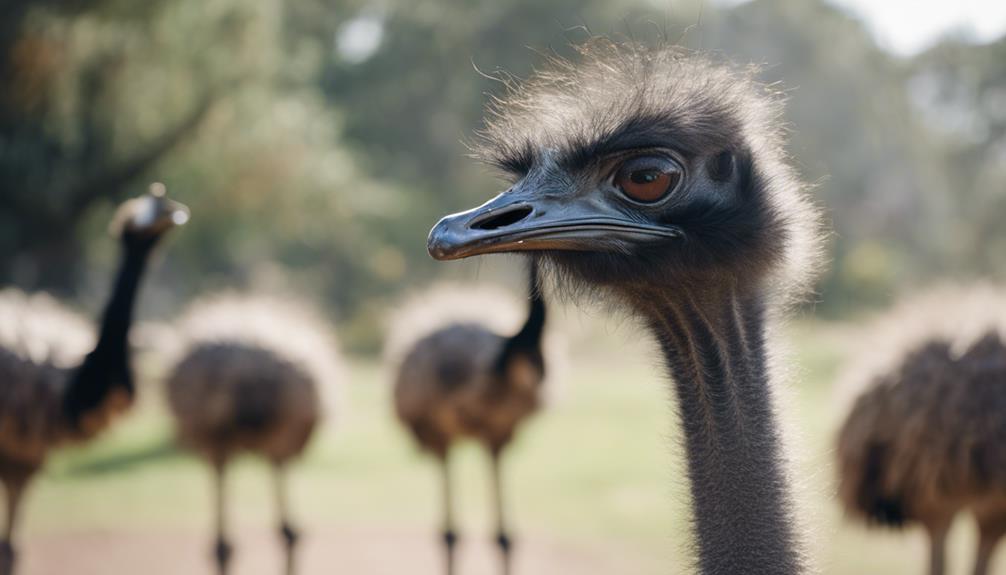
Emus and ostriches exhibit significant differences in neck length, a defining feature that sets these two large flightless birds apart. The ostrich, known for having the longest neck of any bird species, boasts a neck that can reach up to 9 feet in length. This elongated neck serves various purposes, such as allowing the ostrich to spot predators from afar and reach high branches for food. In contrast, the emu, while still possessing a long neck in comparison to many other birds, has a more modest neck length that typically ranges around 1.3 to 1.5 meters.
The disparity in neck length between emus and ostriches is a result of their distinct evolutionary paths and ecological adaptations. Ostriches, native to the African savannas, have evolved their long necks to thrive in open landscapes where visibility is crucial for survival. On the other hand, emus, found in the Australian bushlands, have adapted with a slightly shorter neck suited for browsing vegetation at lower heights. This divergence in neck length showcases the specialized evolutionary strategies each bird has developed to excel in its respective habitat.
Habitat Range
In their natural habitats, emus and ostriches occupy distinct ranges that reflect their evolutionary adaptations to specific environmental conditions. Emus, native to Australia, are well-suited to the diverse landscapes of the continent, ranging from eucalyptus forests to open plains. Their ability to thrive in such varied environments showcases their adaptability and resilience.
Ostriches, on the other hand, are found in the savannas and grasslands of Africa, where their large size and powerful legs allow them to navigate the vast open spaces with ease.
Emus prefer the temperate climates and arid regions of Australia, where they can utilize their long legs for swift running and endurance in the search for food and water. In contrast, ostriches inhabit the more tropical and subtropical regions of Africa, relying on their speed and keen eyesight to evade predators in the grassy plains where they reside.
Both species have evolved to excel in their respective habitats, demonstrating the power of adaptation and survival in diverse ecosystems.
Egg Size

With regards to egg size, a notable distinction can be observed between emus and ostriches in their reproductive biology. Ostrich eggs are the largest of any bird species, typically weighing between 2 to 4 pounds and possessing a volume of around 1.3 liters. These colossal eggs are known for their thick shells and impressive size, making them the largest single cells produced by any living organism.
In contrast, emu eggs are also sizable but are relatively smaller than ostrich eggs. Emu eggs weigh around 1 to 1.4 pounds on average and hold a volume of approximately 0.5 liters. Despite being smaller than ostrich eggs, emu eggs are still larger than the eggs of most other bird species.
The significant size disparity between emu and ostrich eggs is a crucial factor in understanding the reproductive differences between these two magnificent flightless birds.
Foot Structure
Comparing the foot structures of emus and ostriches, what distinctive features highlight their adaptations for different environments and behaviors?
Emus possess three toes on each foot, with a sharp claw on each toe, ideal for traversing rugged terrains and defending against predators. These powerful feet enable emus to run at impressive speeds and make sharp turns, crucial for survival in their natural habitats.
In contrast, ostriches have two toes on each foot, with a formidable main toe armed with a long, sharp claw, perfect for delivering powerful kicks to deter threats. The specialized structure of ostrich feet aids in maintaining balance while running at phenomenal speeds, making them the fastest birds on land.
The differences in foot structure between emus and ostriches reflect their distinct evolutionary paths and the specific demands of their environments, showcasing how each species has adapted to thrive in their respective habitats.
Social Behavior
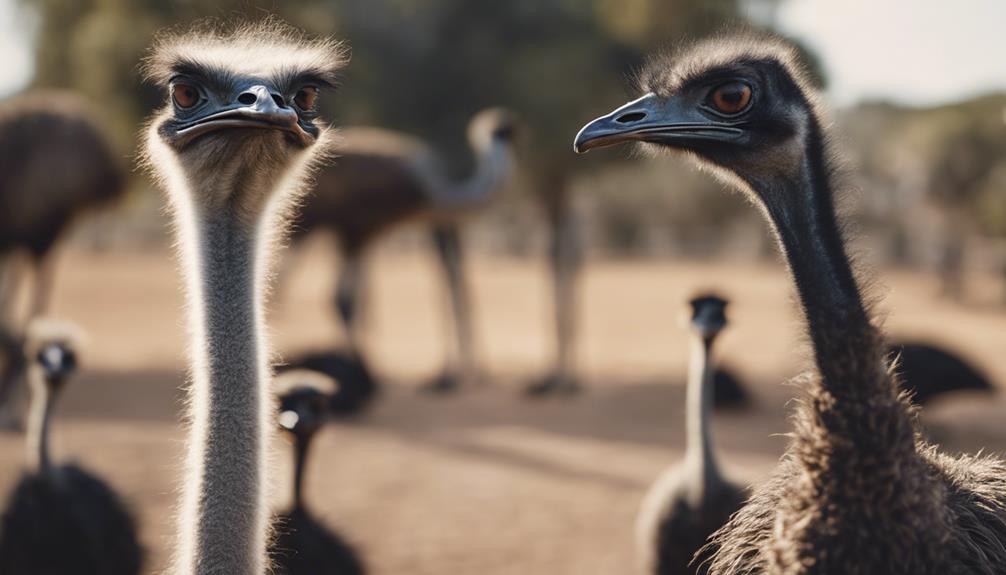
Emus and ostriches also exhibit intriguing differences in their social behavior, shedding light on how these birds interact within their respective groups and ecosystems. Emus tend to be more solitary birds, often foraging and moving alone or in small groups of two to three individuals. They are generally less aggressive towards other emus and tend to avoid conflict within their social structure. On the other hand, ostriches are more social creatures, living in larger groups of around 10-20 individuals. These groups are hierarchical, with dominant males leading the flock and defending the territory against intruders. Ostriches are known to be territorial and can display aggressive behavior, especially during the breeding season.
| Social Behavior | Emu | Ostrich |
|---|---|---|
| Group Size | Small groups (2-3) | Large groups (10-20) |
| Social Structure | Less aggressive, solitary | Hierarchical, dominant males lead |
| Aggression | Avoids conflict | Can be aggressive, especially during breeding season |
Vocalizations
When observing emus and ostriches, one notable aspect to consider is their distinct vocalizations, which play a crucial role in communication within their respective social groups. Emus produce deep booming sounds that can be heard over long distances, serving as a means to establish territory or attract mates. These vocalizations are characterized by low-frequency tones that resonate powerfully through the environment, asserting dominance and strength within the group hierarchy.
On the other hand, ostriches are known for their diverse range of vocalizations, including booming calls, hisses, and grunts. These vocalizations serve various purposes such as warning of danger, attracting a mate, or communicating within the flock. Ostriches can produce a range of sounds that convey different messages, allowing for complex social interactions and coordination within the group.
Speed and Agility
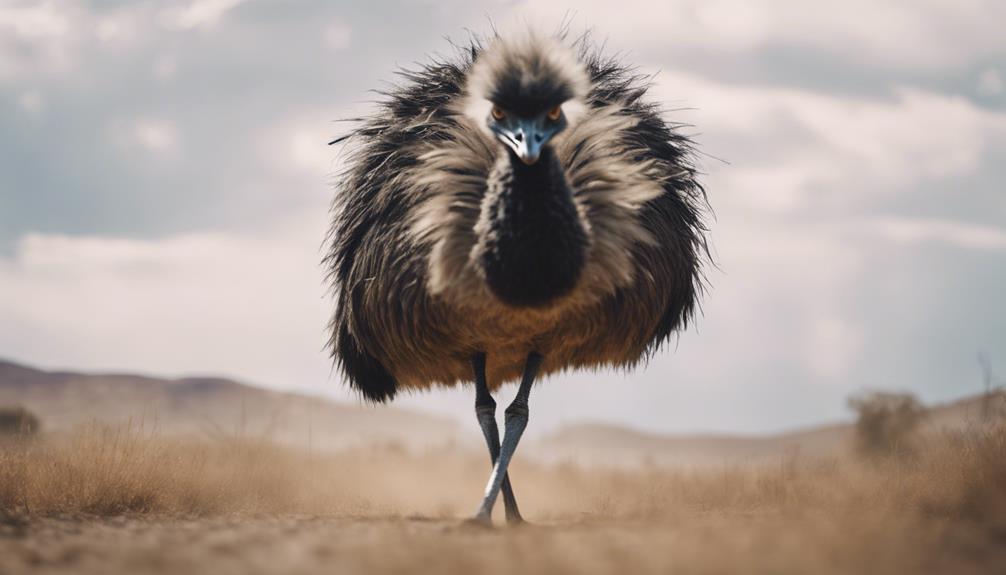
Demonstrating remarkable swiftness and nimbleness, both emus and ostriches exhibit exceptional speed and agility in their movements, enabling them to navigate their environments with incredible efficiency.
Emus, known for their agility, can reach speeds of up to 30 miles per hour, making them adept at evading predators and covering vast distances. Their slender legs and powerful muscles contribute to their rapid acceleration and ability to change direction swiftly.
Ostriches, on the other hand, are the fastest birds on land, capable of sprinting at speeds exceeding 45 miles per hour. Their long legs with two toes equipped with sharp claws aid in maintaining balance and propelling them forward with impressive force.
This exceptional speed and agility not only serve as defensive mechanisms but also facilitate hunting and foraging activities, highlighting the evolutionary adaptations that have honed these birds into formidable creatures of speed and power.
Diet Preferences
In their dietary preferences, emus and ostriches exhibit distinct differences in their food choices and consumption habits. Emus are omnivores, consuming a wide variety of plants, insects, and small vertebrates. They've a keen sense of foraging, often eating fruits, seeds, and even small rodents.
Ostriches, on the other hand, are primarily herbivores, feeding on seeds, shrubs, flowers, and grasses. They've a selective feeding behavior, often preferring certain types of vegetation over others.
Emus tend to consume smaller quantities of food more frequently throughout the day, while ostriches have a slower metabolism and can survive longer periods without food. This difference in feeding habits is partly attributed to their habitats; emus inhabit a more varied landscape with access to different food sources, whereas ostriches are adapted to the arid savannas where vegetation can be scarce.
Understanding these dietary distinctions sheds light on how these majestic birds have evolved to thrive in their respective environments.
Reproductive Differences
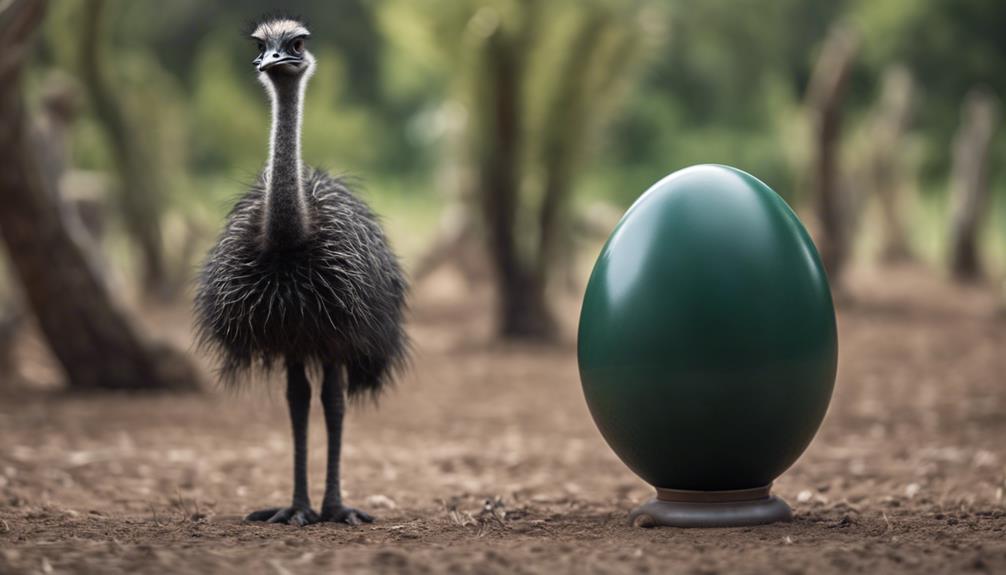
Reproductive strategies differ significantly between emus and ostriches, showcasing distinct adaptations to ensure successful breeding in their respective environments. Emus typically form monogamous bonds that last for several breeding seasons, with the male taking the lead in constructing a nest and incubating the eggs. In contrast, ostriches exhibit a polygamous mating system where a dominant male mates with multiple females, who then lay their eggs in a shared nest. This strategy increases genetic diversity within the ostrich population.
Emus lay dark green eggs, which are then incubated by the male for around 56 days. The male emu is solely responsible for incubation and caring for the young chicks once they hatch. Ostriches, on the other hand, lay the largest eggs of any bird species, with a pale, creamy color. Incubation duties are shared between the dominant male and the females, with the females taking turns throughout the day and night to protect the eggs. These differences in reproductive behaviors highlight the unique adaptations each species has evolved to thrive in their respective habitats.
Conservation Status
The conservation status of emus and ostriches significantly reflects the impact of human activities on their populations. Emus, classified as 'Least Concern' by the IUCN Red List, have a relatively stable population. This is partly due to successful conservation efforts and the adaptability of emus to various habitats. However, ongoing threats such as habitat destruction, climate change, and collisions with vehicles still pose risks.
In contrast, ostriches face a more precarious situation, with their conservation status listed as 'Vulnerable'. The decline in ostrich numbers is primarily attributed to hunting for their feathers, skin, and meat, as well as habitat loss. Conservation initiatives focusing on sustainable hunting practices and habitat protection are crucial for the long-term survival of ostrich populations.
Understanding the conservation status of both emus and ostriches is essential for implementing effective measures to safeguard these iconic species. By addressing the root causes of population decline, we can contribute to the preservation of these magnificent birds for generations to come.
Frequently Asked Questions
Can Emus and Ostriches Fly?
Emus and ostriches cannot fly due to their large size and lack of proper wing structures. These flightless birds rely on their strong legs for running at high speeds, which is their primary mode of mobility.
Do Emus and Ostriches Have Any Predators?
You might think emus and ostriches, with their size and speed, have no predators. However, these flightless birds face threats from animals like dingoes and eagles. Their powerful legs are their main defense against these potential predators.
How Long Do Emus and Ostriches Live?
Emus and ostriches live for different lengths of time. Emus typically live around 10-20 years, while ostriches can live up to 40-50 years. Factors like captivity, diet, and habitat influence their lifespan significantly.
Are Emus and Ostriches Kept as Pets?
You can keep emus and ostriches as pets, but it requires extensive knowledge and resources. Both birds need ample space, specialized diets, and proper care. Consider legal restrictions and the commitment involved before deciding to have them as pets.
Are Emu and Ostrich Eggs Edible?
Yes, both emu and ostrich eggs are edible. They are rich in nutrients and can be cooked in various ways. Emu eggs are larger and have a milder flavor, while ostrich eggs are more substantial.
Conclusion
In conclusion, when comparing emus and ostriches, it's clear that they've distinct differences in physical characteristics, habitat adaptations, and social behaviors.
While emus are smaller and form monogamous bonds, ostriches are larger, faster, and engage in a polygamous mating system.
One example of these differences is the unique nest-sharing behavior of emus, where both male and female birds take turns incubating the eggs, showcasing their strong familial bonds.




